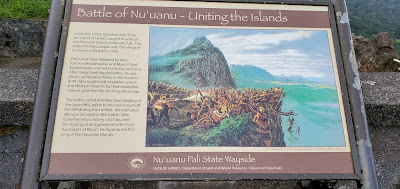Just got back from a visit to see family back in Hawaii. Besides eating a lot of great chow, drove around the island to see what had changed since my last visit 10 years ago. A lot more people and cars, but the weather and nature are still beautiful as ever. Here are a few shots at some sites of interest related to military history.
The old Type 95 Ha-Go outside the Fort DeRussy Army Museum - behind it is an M24 Chaffee. Both faded unsurpsingly being exposed to the sunshine. The museum itself is built in and around the old Battery Randolph structure. Admission to the museum is free, but I didn't go in this time. I've been to it a few times before though. It's right in Waikiki and next to the Hale Koa military hotel.Up at the Pali Lookout (pali means cliff in Hawaiian). This is a very soulful place where hundreds of Oahu defenders were either forced off the cliff by Kamehameha's invading army or jumped off during the battle there in 1795. Hundreds of skulls and skeletons of these warriors were found during construction of the old Pali road in the late 1800's. That's Kaneohe in the background in the picture above, and home to the 3rd Marine Littoral Regiment, and Marine Aircraft Group 24, among other units.After visiting the Pali, had to stop by and take a picture of the statue of King Kamehameha - unifier/conqueror of the Hawaiian islands. The statue stands in front of Iolani Palace - which was the home of Hawaiian royalty, all the way until it was used to imprison the last Hawaiian monarch, Queen Liliʻuokalani in the late 1800's, after the overthrow of the Hawaiian Kingdom by American businessmen and a few sailors. Incidentally, my first-cousin, a half-Hawaiian, Charles Ka'ai'ai, Jr., led a reenactment of this overthrow back in the 1990's. His dad was a 100% Hawaiian, served in WW2 as a Mechant Marine, and is buried in Punchbowl. My cousin himself was drafted into the Army during the Vietnam War, volunteered for Vietnam as an infantryman, but ended up as a guard at Spandau - he said he saw Hess a lot there - and said he was a "weird and bad tempered" when I asked what he was like.Speaking of Punchbowl - went up to tidy up the grave site of my dad - he didn't go overseas during the war, as it ended while he was still Stateside. Besides him and my uncle Charley, there are a couple more of my uncles there.I also rummaged through a lot of our old stuff - sadly a lot of the cool stuff are long gone; like my maternal grandfather's family samurai swords. He had donated them to a temple back in the 1970's when he was getting up in age and thought that would bless him in the next life - or something like that. Some of the stuff we still had in the toolshed were a couple of old artillery shell casings. This one is a 3 inch 50 cal. shell for a naval gun. It has an etching of two soldiers carrying rifles - I think they're supposed to be Japanese soldiers as their helmets look like they have the Imperial star on them.
Here's a picture of the front of the deterioting Natatorium. It was built in the 1920's to honor the 10,000 men from Hawaii who served in WW1. There used to be two huge naval guns on the lawn in front. My dad used to hoist me up on the barrell when I was little, so I could straddle it and play around on top of it. The guns have long since been removed, and may have been relocated somewhere else.
Growing up in Hawaii with a large military presence, I suppose it's not surprising I played "army" a lot as a kid - and later actually played it for a few decades as an adult. For the record, I had relatives on both sides of WW2. My maternal grandmother's oldest son (from a different father than my mom), was a pilot who was shot down over the Battle of Midway. Not sure if he was an actual Kamikaze pilot, but it was verified by his pilot friends to my grandmother that that's how he died. We used to have an old photograph of him next to his plane. My dad's oldest brother was going to a university in Japan when the war broke out and was conscripted into the IJA - he survived the war, and his father had to spend a lot of money on lawyers to get thim back home. He never spoke of the war to anyone - so not sure what he did or where he actually may have served. Several uncles on my mom's side, who were from Washington State, were first interned in Minidoka, Idaho, than volunteered and served in Europe with the 442nd Regimental Combat Team. They all survived the war and used to have reunions with the Texas "Lost Battalion" whom they rescued at the Vosges Mountains, France.




















